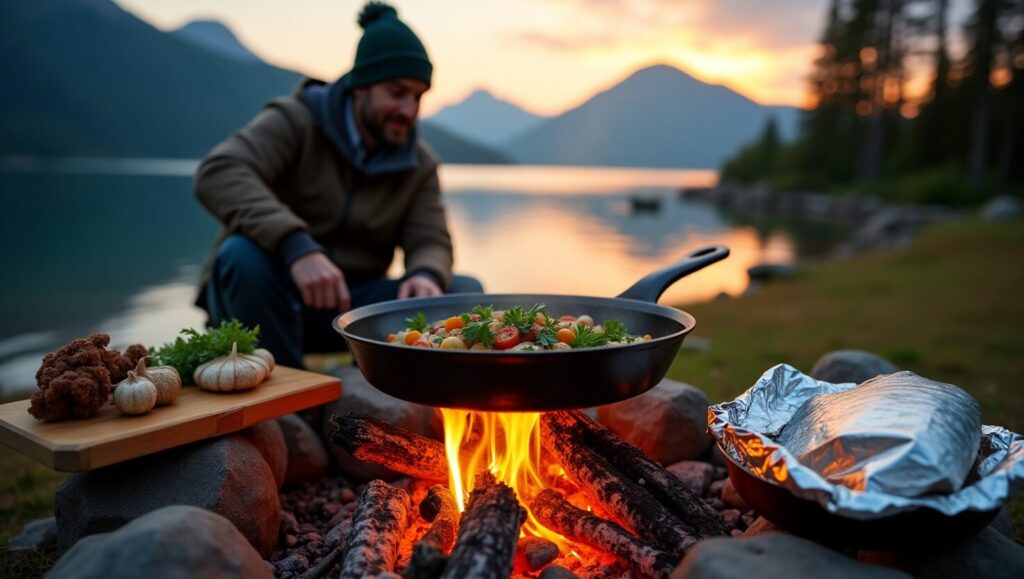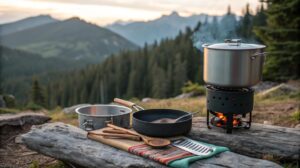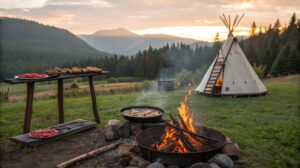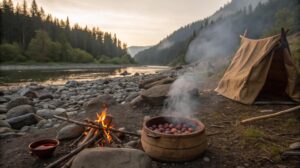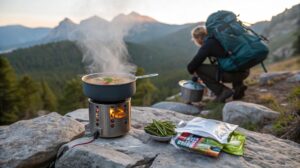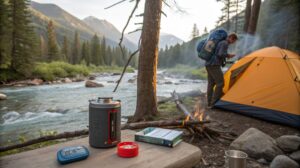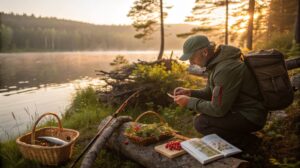Introduction:
When was the last time you enjoyed a meal cooked over an open flame, surrounded by towering trees and the soothing sounds of nature? There’s something magical about wilderness cooking techniques that transforms even the simplest ingredients into unforgettable meals. According to a 2024 Outdoor Industry Association report, nearly 65% of campers rank cooking outdoors as their favorite camping activity.
As someone who has spent countless nights under the stars, I can confidently say that mastering wilderness cooking techniques doesn’t just fill your belly—it feeds your soul. Whether you’re a weekend warrior or planning an extended backcountry expedition, this guide will equip you with the knowledge to create delicious meals wherever your adventures take you.
Essential Wilderness Cooking Equipment
When it comes to cooking in the wilderness, having the right gear can make the difference between a frustrating experience and a delightful outdoor culinary adventure. As someone who’s spent countless nights cooking under the stars, I’ve learned that equipment selection is deeply personal and depends on your specific needs.
I still remember my first backpacking trip where I lugged a cast iron skillet up a mountain. Big mistake! My shoulders ached for days. Now I know that balancing weight, durability, and functionality is the key to wilderness cooking success.
Choosing the Right Cookware
For most trips, I’ve found that a lightweight titanium pot set offers the best combination of:
- Weight savings
- Cooking versatility
- Quick heating & easy cleaning
- Compact nesting design
Plus, they last forever—my primary pot has survived 12 years of adventures and still looks almost new!
Portable Stoves vs. Campfires
Portable stoves have completely transformed my wilderness cooking game. While nothing beats the ambiance of a campfire, stoves provide:
- Reliability & Precision
- Stable cooking surfaces
- Fuel efficiency
After trying dozens of models, I’ve settled on a remote canister stove for most of my trips. They work great in cold weather and sip fuel efficiently.
That said, don’t overlook the humble campfire! There’s something primal and satisfying about cooking over an open flame. Just make sure you understand local fire regulations before planning a fire-cooked meal.
I once planned an elaborate Dutch oven dinner, only to arrive at a total fire ban area. Lesson learned!
The Versatility of Dutch Ovens
Speaking of Dutch ovens, if you’re car camping or have pack animals, these heavy cast iron wonders create meals that rival home cooking.
- Superior heat retention & distribution
- Perfect for baking, roasting & stews
- Turns a basic campsite into a gourmet kitchen!
I’ve literally had fellow campers follow their noses to my campsite when using my Dutch oven!
Multi-Purpose Utensils: The Key to Packing Light
For utensils, multi-purpose is the name of the game.
My favorite tool is a simple wooden spoon with one edge slightly flattened. It serves as:
- A stirrer
- A spatula
- A measuring device
- Even a dough kneader in a pinch!
- Talk about bang for your buck!
Budget-Friendly Gear Alternatives
Budget-conscious beginners shouldn’t feel pressured to buy expensive gear. Some of my most successful wilderness meals were prepared with repurposed household items:
- An old aluminum pot works fine for boiling water.
- A cleaned-out tuna can makes a serviceable alcohol stove.
Start simple, then upgrade as you discover your specific needs.
Managing Temperature Control
Temperature control is one of the biggest challenges in wilderness cooking.
That’s why I never go without my silicone potholder—it’s:
- Lightweight
- Doubles as a trivet
- Has saved my hands from countless burns!
Sometimes it’s the small items that make the biggest difference in your outdoor cooking experience!
Fire-Building Techniques for Cooking
I’ll never forget my first attempt at cooking over an open fire. What I thought would be a simple task turned into a smoky disaster that left me with charred food on the outside and raw centers. Talk about a humbling experience!
Over the years, I’ve learned that fire-building for cooking isn’t just about getting flames going—it’s about creating the right kind of heat for what you’re trying to cook. And let me tell you, that knowledge didn’t come easy.
Understanding Fire Heat: Flames vs. Coals
The biggest mistake I made when starting out? Building one massive fire and trying to cook everything over it. Rookie move! Now I know that different cooking methods require different fire configurations.
For most cooking situations, you’ll want to work with coals rather than flames.
- Flames look impressive, but they’re wildly inconsistent and will leave your food burnt on the outside while still raw inside. Been there, done that, got the indigestion to prove it!
- Coals, on the other hand, provide steady heat, making them ideal for cooking.
Fire Structures for Cooking
Different fire structures serve different cooking purposes.
1. The Teepee Fire – Best for Quick Cooking & Grilling
When I’m planning to grill directly over fire, I swear by the teepee fire structure.
How to build it:
- Start with a small pile of tinder in the center.
- Surround it with kindling arranged in a cone shape.
- Leave an opening on the side facing the wind.
Why it works:
- Creates a concentrated heat source.
- Perfect for searing meat & fast grilling.
2. The Log Cabin Fire – Best for Even Cooking & Coals
For more controlled cooking, the log cabin structure has become my go-to.
How to build it:
- Stack logs in alternating layers, just like Lincoln Logs.
Why it works:
- Burns evenly.
- Creates a perfect bed of coals for consistent heat.
3. The Star Fire – Best for Temperature Control
Here’s a trick I learned from an old trail guide in Montana: the star fire.
How to build it:
- Arrange 5-6 logs like spokes on a wheel, with their ends meeting at the center where your tinder is.
- As the fire burns, push the logs inward.
Why it works:
- Offers amazing temperature control.
- Reduces the need to constantly add wood.
Finding & Selecting Firewood
Finding dry tinder can be a nightmare when conditions are wet. I once spent three hours trying to start a fire during a drizzle in the Olympic rainforest. Not fun!
Pro tip:
- Check under fallen logs or inside standing dead trees for dry material.
- The inner bark of cedar stays dry even in wet conditions.
Best Woods for Cooking
Different woods create different cooking experiences:
-
Hardwoods (oak, maple, fruit woods):
-
Burn slower & hotter.
-
Create long-lasting coals.
-
Perfect for most cooking.
-
-
Softwoods (pine, fir, spruce):
-
Burn hot & fast.
-
Great for boiling water.
-
❌ Terrible for cooking meat (too much soot & resin).
Fire Safety: Essential Rules
Safety’s no joke when it comes to wilderness fires.
I’ve seen small cooking fires turn into dangerous situations faster than you can say “marshmallow.”
- Always clear a 10-foot diameter around your fire site.
- Keep water nearby.
- Make sure your fire is completely out before leaving.
That means cool to the touch—not just “looks out.”
Primitive Cooking Methods
I’ve always been fascinated by how our ancestors prepared meals without modern conveniences. My first attempt at primitive cooking was a humbling experience—I tried to roast a fish on a stick over an open flame and ended up with a charred exterior and raw interior. Not exactly the wilderness feast I had imagined!
Rock Boiling: Cooking with Heated Stones
Rock boiling changed everything for me. This ancient technique involves heating rocks in a fire until they’re glowing hot, then carefully transferring them into a container of water. I’ve used everything from hollowed logs to tightly woven baskets lined with clay. The first time I successfully made a stew this way felt like I’d unlocked some ancient secret!
Pit Cooking: Slow-Cooked Perfection
On one memorable backpacking trip, our stove broke on day two of a seven-day journey. Rather than subsisting on granola bars, we dug a pit about 2 feet deep, lined it with rocks, and built a fire inside. After the fire burned down to coals, we wrapped our food in leaves, placed it in the pit, covered everything with dirt, and built a small fire on top. Six hours later, we unearthed the most tender, flavorful trout I’ve ever tasted.
Stick Spit Roasting: The Art of Even Cooking
Creating an effective stick spit takes more finesse than you might think. I learned the hard way that you need to select green wood (not dry) for your spit, otherwise, it’ll catch fire along with your dinner! The Y-shaped support sticks should be sturdy and driven deep into the ground. Nothing worse than watching your whole setup collapse just as the food is nearly done—trust me on this one!
Earth Ovens: Nature’s Slow Cooker
The earth oven (or pit oven) has become my go-to method for cooking when I’m not in a hurry. The slow, even heat creates incredible flavor and tenderness. I once cooked a whole chicken with foraged herbs and wild onions in an earth oven while on a three-day canoe trip. My paddling partners still talk about that meal years later!
Using Natural Materials as Cooking Tools
What I love most about primitive cooking is how it connects you to the landscape. Instead of carrying everything on your back, you learn to use what’s available—flat stones become griddles, hollowed logs become vessels, clay from riverbanks can be molded into temporary cooking pots. It’s like the wilderness becomes your kitchen.
The Dakota Fire Hole: Efficient and Low-Smoke Cooking
Some of my most successful wilderness meals have utilized methods practiced by indigenous cultures. The Dakota fire hole—a small, efficient fire pit with an air intake tunnel—produces intense heat with minimal fuel and very little smoke. It’s perfect for cooking in windy conditions or when you need to be discreet.
Why Primitive Cooking Methods Still Matter
I’ve found that primitive cooking methods aren’t just about necessity—they often produce better results than modern techniques. Food cooked slowly underground develops complex flavors that you just can’t get from a portable stove. There’s something about the smoke, the earthiness, and the patience required that transforms simple ingredients.
Managing Time When Cooking Without Modern Tools
The biggest challenge with primitive cooking? Time management. These methods rarely offer the instant gratification of modern cooking. I’ve learned to start my cooking fire hours before I’m actually hungry and to find ways to enjoy the process rather than focusing solely on the outcome.
Modern Wilderness Cooking Approaches
As much as I love primitive methods, I’ll be the first to admit that modern wilderness cooking techniques have revolutionized what’s possible in backcountry cuisine. Gone are the days when outdoor meals meant bland, rehydrated mush, or burnt hotdogs on sticks!
Dehydrated Meals: Lightweight and Customizable
Dehydrated meals have come a long way since I first started backpacking.
- I remember choking down some truly awful commercially prepared options in the early 2000s.
- These days, I dehydrate most of my own meals at home, which saves money and lets me control exactly what goes into my food.
- The trick is to slightly undercook pasta and rice before dehydrating—they’ll finish cooking perfectly when you rehydrate them in camp.
One-Pot Meals: Efficiency and Minimal Cleanup
One of my absolute game-changers was mastering the art of one-pot meals.
- On a challenging 14-mile day in the Rockies, the last thing I wanted was to wash multiple dishes in frigid mountain water.
- Now I layer ingredients in a single pot based on cooking time—dense vegetables and grains at the bottom, quick-cooking items on top.
- By the time I reach camp, I can have a complete meal ready in under 15 minutes with minimal cleanup.
Backcountry Baking: The “Baking Twiggy” Trick
I’ll never forget the looks on my hiking buddies’ faces when I pulled freshly baked cinnamon rolls out of my backpacking setup.
- Backcountry baking seemed impossible until I discovered the wonders of the “baking twiggy.”
- It’s essentially a tiny platform made from green sticks that sits inside your pot, allowing you to bake without scorching the bottom of your food.
- Game-changer!
Foil Packet Cooking: Prepped at Home, Effortless in Camp
Foil packet cooking has saved me countless times when I’m too tired to think straight after a long day of hiking.
- I prepare the packets at home—protein, vegetables, and seasonings all sealed tight in heavy-duty foil.
- At camp, I just toss them on hot coals for 10-15 minutes, and dinner is served with zero cleanup.
- My favorite combo is diced sweet potatoes, black beans, and chorizo with a sprinkle of smoked paprika.
Sous-Vide in the Backcountry: A Surprisingly Fancy Touch
Even in the wilderness, I’ve found ways to get pretty fancy with my cooking.
- Using a lightweight silicone bag and hot water from my stove, I’ve successfully made sous-vide eggs for breakfast burritos.
- Were they technically perfect sous-vide eggs? Maybe not.
- Were they delicious and impressive at 10,000 feet? Absolutely!
Bag Omelet: A No-Mess Breakfast Solution
One technique that’s revolutionized my breakfast game is the “bag omelet.”
- Beat eggs and add ingredients at home, then freeze in a ziplock and let it thaw in your pack.
- When morning comes, drop the bag in simmering water for a perfect omelet with no pan to clean.
- I’ve converted numerous freeze-dried breakfast devotees with this simple trick.
Planning and Meal Strategy: Avoiding Excess Weight and Waste
The secret to successful wilderness cooking isn’t just about techniques—it’s about planning.
- I learned to create a detailed meal plan that considers the weight of ingredients, cooking time, fuel requirements, and even how leftovers might be incorporated into future meals.
- My first few trips involved carrying way too much heavy food that went uneaten.
- Now I can accurately predict exactly what I’ll need.
Cooking with Beverage Cans: Improvisation in the Wild
One of my favorite recent discoveries is cooking with beverage cans.
- A cleaned aluminum can cut in half becomes a serviceable pot or frying pan in a pinch.
- I once salvaged a trip when my cooking pot developed a crack by using this method.
- The eggs I cooked in that makeshift aluminum pan might have been the most satisfying I’ve ever eaten—necessity really is the mother of invention!
Here’s a quick summary/comparison of these techniques:
| Technique | Best For | Pros | Cons |
|---|---|---|---|
| Grilling | Meats, veggies | Quick and easy | Requires constant attention |
| Tin Foil Cooking | Fish, potatoes | Minimal cleanup | Limited to small portions |
| Dutch Oven | Stews, bread | Versatile | Heavy to carry |
| Boiling/Steaming | Pasta, veggies | Simple and efficient | Requires water source |
| Smoking | Meat preservation | Long-lasting results | Time-consuming |
Wilderness Food Safety and Preservation
Foraging and Fishing to Supplement Your Meals
There’s something deeply satisfying about incorporating wild foods into your wilderness meals.
The Golden Rule of Foraging: Safety First
That said, I approach foraging with extreme caution—my first rule is “when in doubt, go without.”
- No wild berry or mushroom is worth a helicopter evacuation!
My First Foraging Experience: A Game-Changer
I still remember my introduction to edible wild plants.
- An experienced forager showed me how to identify lamb’s quarters, a wild relative of quinoa that grows practically everywhere.
- That night, we sautéed the leaves with a little olive oil and garlic.
- The earthy, spinach-like flavor completely changed how I thought about “weeds.”
Beginner-Friendly Edible Plants
Starting with easily identifiable plants with no dangerous look-alikes is absolutely essential.
- Wild berries like blackberries, raspberries, and blueberries are perfect for beginners.
- I once collected enough wild blueberries in northern Minnesota to make pancakes for my entire group—easily the most memorable breakfast of the trip!
- Dandelions have become one of my favorite trail-side supplements:
- Young leaves make a slightly bitter salad green.
- Flowers can be battered and fried into fritters.
- Roots can even be roasted and ground as a coffee substitute.
Fishing: A Lightweight Game-Changer
Fishing has transformed many of my wilderness meals from good to incredible.
- I’ve found that a lightweight telescoping rod and a small selection of lures take up minimal pack space but offer huge potential rewards.
- My ultralight fishing setup weighs less than a pound but has provided some of my most memorable wilderness meals.
Simple Yet Effective Fishing Setups
The simplest fishing setups often work best.
- A hand line with some basic hooks and weights fits in an Altoids tin but can be surprisingly effective, especially for pan fish like bluegill and perch.
- I’ve caught dinner with nothing more than:
- Fishing line wrapped around a plastic bottle
- A safety pin bent into a hook
- A bit of bright thread as a lure
- In survival situations, these improvised tools could be absolute lifesavers.
Cooking Freshly Caught Fish: The Hot Rock Method
Preparation methods for freshly caught fish don’t have to be complicated.
- One of my favorites is the “hot rock” method:
- Clean your fish
- Stuff the cavity with wild herbs and lemon slices (if you have them)
- Wrap in leaves
- Place between hot flat rocks from your fire
- Wait ten minutes and enjoy the freshest possible protein source!
Ethical Foraging and Fishing: Respecting Nature
Ethical considerations around foraging and fishing are extremely important to me.
- I never harvest more than I need.
- I always follow local regulations regarding fishing limits.
- I take care to harvest plants in a way that allows them to continue growing.
- With wild mushrooms, I’m careful to leave the mycelium undisturbed and only take a portion of what I find.
Edible Plant Identification: The Three-Feature Rule
Accurately identifying edible plants requires multiple confirming characteristics.
- I’ve developed the habit of checking at least three distinct features before consuming any wild plant.
- One afternoon in the Cascades, I found what looked like wild onions, but when I checked for the distinctive onion smell, it was absent.
- Good thing I didn’t eat them—they were likely death camas, which can be fatal even in small amounts!
The Most Valuable Lesson: Patience in ForagingThe most valuable lesson I’ve learned about foraging is patience.
- Building knowledge takes time, and there are no shortcuts when your health is on the line.
- I spent three years studying edible mushrooms before I felt confident harvesting and eating my first wild morels.
- That cautious approach has served me well, allowing me to safely enjoy nature’s pantry while respecting its power.
Conclusion:
Wilderness cooking is both an art and a science—one that rewards experimentation and practice. By mastering these techniques, you’ll not only create memorable meals but also forge a deeper connection with the natural world. The skills outlined in this guide will serve you well whether you’re enjoying a weekend camping trip or embarking on an extended backcountry adventure.
Remember that the best wilderness meals are often the simplest ones, prepared with care and enjoyed in good company. So pack your gear, head into the wild, and start creating culinary magic under the open sky!
Got a wilderness cooking win (or disaster)? Share it in the comment section! Let’s swap stories and spice up our next adventures.
Additional Resources
- Leave No Trace: Offers comprehensive ecosystem knowledge and how avoiding fire protects the environments
- 10 Campfire Recipes That Won’t Bomb: Check out this curated list of campfire recipes that keep you going off-grid during camping
- Ultimate Guide to Wilderness Survival Skills: Talks comprehensively about survival skills in the wild or off-grid.
- How to Stay Safe While Camping Off-Grid: Offers safety and survival tips in the wilderness
-
Wilderness Survival Guide: Offers practical advice on wilderness survival, highlighting the role of mental attitude.
-
Mental Survival Techniques: Discusses mental techniques for staying calm and focused during hikes.
Frequently Asked Questions
Q1: What are the essential tools for wilderness cooking?
Essential tools include a portable stove or camping gear for fire-building, lightweight cookware like titanium pots, multi-purpose utensils, and a bushcraft hatchet for preparing firewood. Don’t forget a cast iron skillet or Dutch oven for versatile cooking options.
Q2: How do I choose between portable stoves and campfires?
Portable stoves offer precision and convenience, especially in areas with fire restrictions or bad weather. Campfires provide an authentic experience and allow for grilling and roasting. Choose based on your location and weather conditions.
Q3: What are some primitive cooking methods I can try?
Primitive methods include rock boiling, pit cooking, and using stick spits for roasting. These techniques connect you to ancient traditions and can be incredibly rewarding.
Q4: How do I ensure food safety while cooking in the wilderness?
Always store food properly, especially in bear country, and use natural refrigeration methods like streams or shaded pits for perishables. Ensure all food is cooked to safe temperatures to avoid foodborne illnesses.
Q5: What are some budget-friendly options for wilderness cooking gear?
Start with repurposed household items like aluminum foil for packet meals or old pots for boiling water. Basic utensils and a simple camping stove can also be cost-effective options for beginners.

